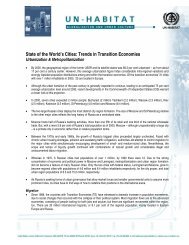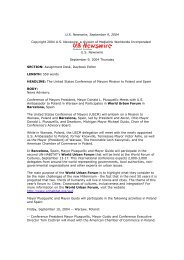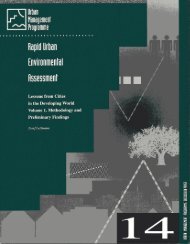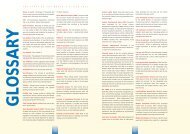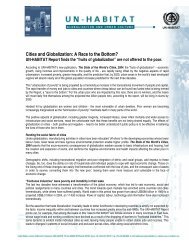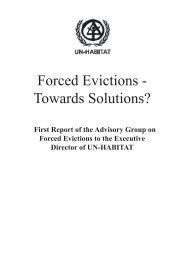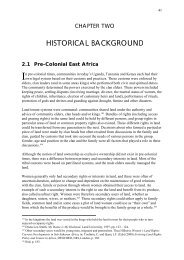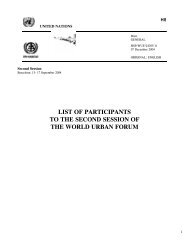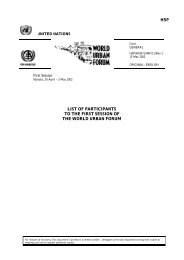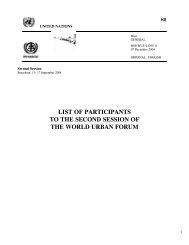a framework for reforming urban land policies in ... - UN-HABITAT
a framework for reforming urban land policies in ... - UN-HABITAT
a framework for reforming urban land policies in ... - UN-HABITAT
You also want an ePaper? Increase the reach of your titles
YUMPU automatically turns print PDFs into web optimized ePapers that Google loves.
Box 2: Land-Use Plann<strong>in</strong>g <strong>in</strong> Zhejiang Prov<strong>in</strong>ce<br />
In Zhejiang Prov<strong>in</strong>ce vast areas of agricultural <strong>land</strong> on the fr<strong>in</strong>ges of cities are be<strong>in</strong>g converted to <strong>urban</strong> uses. In<br />
Hangzhou, <strong>for</strong> example, total residential floorspace more than doubled between 1980 and 1986. The massive<br />
expansion of <strong>urban</strong> areas is the direct result of population <strong>in</strong>creases triggered by migration, Ch<strong>in</strong>a’s vigorous<br />
hous<strong>in</strong>g construction programs which have <strong>in</strong>creased the amount of floorspace <strong>in</strong> the prov<strong>in</strong>ce by 50 percent<br />
s<strong>in</strong>ce 1980, and the development of new economic activities which require <strong>land</strong> <strong>for</strong> <strong>in</strong>dustrial estates (World<br />
Bank, 1987).<br />
The rate and extent of <strong>land</strong> conversion <strong>in</strong> Zhejiang is largely conditioned by <strong>urban</strong> plann<strong>in</strong>g <strong>policies</strong> implemented<br />
by cities. Despite the fact that agricultural <strong>land</strong> is very scarce, <strong>urban</strong> plann<strong>in</strong>g standards call <strong>for</strong> a reduction <strong>in</strong><br />
the density of development <strong>in</strong> Zheijiang <strong>urban</strong> areas to a very low 150 persons per hectare density. This outcome<br />
reflects the fact that plann<strong>in</strong>g is completely divorced from resource constra<strong>in</strong>ts or the discipl<strong>in</strong>e of market<br />
pressures. If present <strong>land</strong>-use <strong>policies</strong> and norms cont<strong>in</strong>ue, <strong>urban</strong>ized <strong>land</strong> <strong>in</strong> Zhejiang Prov<strong>in</strong>ce will <strong>in</strong>crease by<br />
140 percent, from 21,600 hectares <strong>in</strong> 1985 to 51,800 hectares <strong>in</strong> the year 2000. On the other hand, if future <strong>urban</strong><br />
development occurred at the typical higher densities found <strong>in</strong> other large cities (gross densities of 210 persons per<br />
hectare), the <strong>land</strong> requirements to meet future development would be slashed to 50 percent of the master plan<br />
amount – 36,700 hectares. The rigid application of current master plan <strong>policies</strong> results <strong>in</strong> a dramatic reduction <strong>in</strong><br />
population density <strong>in</strong> the four pr<strong>in</strong>cipal cities of the prov<strong>in</strong>ce and considerably more conversion of rural <strong>land</strong> to<br />
<strong>urban</strong> uses (The World Bank, 1987).<br />
2.14 Another action to promote efficient and economically productive <strong>urban</strong> development is<br />
<strong>for</strong> government to redevelop older <strong>urban</strong> areas that are no longer economically productive. In<br />
old cities, central areas are usually ready <strong>for</strong> redevelopment, s<strong>in</strong>ce the hous<strong>in</strong>g stock is frequently<br />
dilapidated and <strong>in</strong>frastructure systems are worn out. Also the pressures of <strong>in</strong>ternational<br />
competition compel cities to modernize factories and commercial centers, requir<strong>in</strong>g massive<br />
redevelopment. Such programs have been fully carried out <strong>in</strong> Taipei, Hong Kong, Seoul,<br />
S<strong>in</strong>gapore, New York, and London (OECD, 1990). In some <strong>in</strong>stances the projects were <strong>in</strong>itiated<br />
by the central government (Paris’ La Defense), <strong>in</strong> other cases they were locally <strong>in</strong>itiated<br />
(London’s Dock<strong>land</strong>s). Certa<strong>in</strong>ly not all attempts have been successful.<br />
2.15 Dock<strong>land</strong>’s required massive subsidies, is poorly served by transit and is now enter<strong>in</strong>g<br />
the property market just when London’s office market is flooded with vacant space.<br />
2.16 Not all government attempts at ensur<strong>in</strong>g an adequate supply of <strong>land</strong> <strong>for</strong> <strong>urban</strong>ization have<br />
worked well. For example, Karachi’s <strong>in</strong>adequate hous<strong>in</strong>g production is due to the lack of<br />
serviced <strong>land</strong> and limited f<strong>in</strong>ance capital. The most visible manifestation of <strong>land</strong> constra<strong>in</strong>ts are<br />
the numerous <strong>in</strong><strong>for</strong>mal hous<strong>in</strong>g settlements, katchi abadis, surround<strong>in</strong>g Karachi. Because these<br />
settlements have proliferated at about twice the rate as the <strong>for</strong>mal sector, over the past ten years<br />
the portion of the population liv<strong>in</strong>g <strong>in</strong> <strong>in</strong><strong>for</strong>mal areas has <strong>in</strong>creased from 25 to nearly 50 percent.<br />
Simply put, because the <strong>for</strong>mal sector has failed to meet the hous<strong>in</strong>g needs of Karachi’s grow<strong>in</strong>g<br />
population, it is becom<strong>in</strong>g <strong>in</strong>creas<strong>in</strong>gly irrelevant.<br />
2.17 In develop<strong>in</strong>g cities around the world, the demand <strong>for</strong> <strong>land</strong> <strong>for</strong> <strong>urban</strong> use is large and<br />
grow<strong>in</strong>g. Accord<strong>in</strong>g to the United Nations, between 1975 and 2000, the annual average<br />
population <strong>in</strong>crease of <strong>urban</strong> areas <strong>in</strong> develop<strong>in</strong>g regions is estimated at 56 million – equivalent<br />
to add<strong>in</strong>g about four Mexico Cities to the world each year. At a gross population density of 210<br />
19




